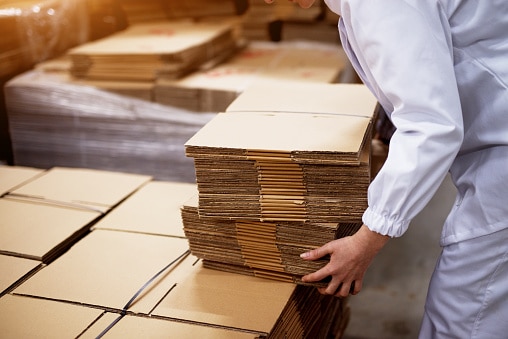Corrugated Boxes: Manufacturing
Corrugated boxes are made in box plant factories. Designed to be strong, they are comprised of corrugated paperboard, which contains air columns. These columns act as cushions, making the box more secure and protecting whatever it is the box is meant to hold safely.
Before a manufacturer builds a box, he must take into consideration the size, shape, strength, color, flutes, and coatings. Depending on the required strength of the box, corrugated boxes may be made of one, two, or three layers of flutes and liners.
The key raw material in corrugating is paper. Different grades of paper comprise each layer that makes up a corrugated box.
The process begins by making a corrugated board on a corrugating line, a long series of linked machines totaling the size of a football field. Paper is fed into the corrugator, where it is steam-heated and pressed to form corrugated cardboard. One roll of cardboard is corrugated and then glued between two other layers. Corn starch glue bonds the corrugated medium (wavy layer) to the liners (layers of paper). Two liners and a corrugated medium make up your standard three-layer corrugated board.
The medium is first fed through the preheating rollers, then into the corrugating rollers. Steam is forced through both sets of rollers at 175-180psi. As the paper passes through, temperatures reach 350-365 degrees Fahrenheit.
The corrugated rolls are then covered with IO flutes. The size of the flute changes the width of the corrugated medium. When the hot paper passes between the corrugating rolls, flutes trap and bend it to form the middle of the corrugated cardboard. A finished piece of corrugated cardboard is comprised of a single corrugated layer sandwiched between two liners.
Next, the corrugated medium goes to the single-facer glue station where one layer of liner is glued to the medium. Then the medium and liner go to the double backer glue station where the layer from the bridge is added. The cardboard is then passed over steam-heated plates, which cure the glue.
At the end of the corrugator, the cardboard is trimmed and cut into large sheets, or box blanks, which then slide into a stacker that loads them onto a platform.
Skilled workers prepare job tickets for each stack of box blanks and route the blanks to fabrication machines. Printing dies and patterns are prepared on large, flexible, rubber, or tin sheets. They are loaded onto rollers and the box blanks are fed through it, where each is trimmed, printed, cut, scored, folded, and glued to form a box. Finished boxes are then stacked and sent to a banding machine to be wrapped and shipped.
Corrugated Boxes: Uses
Popular for their strength, durability, lightness, recyclability, and cost-effectiveness, corrugated boxes are used for the shipping of a variety of items. Due to the quality and safety of packaging items in corrugated boxes, they are used widely in the food industry. The boxes handle the pressure that comes with stacking, making them ideal for easy transport.
More than 95% of all products in the United States are shipped in corrugated boxes. Corrugated paperboard accounts for more than half of all the paper recycled in the US.
